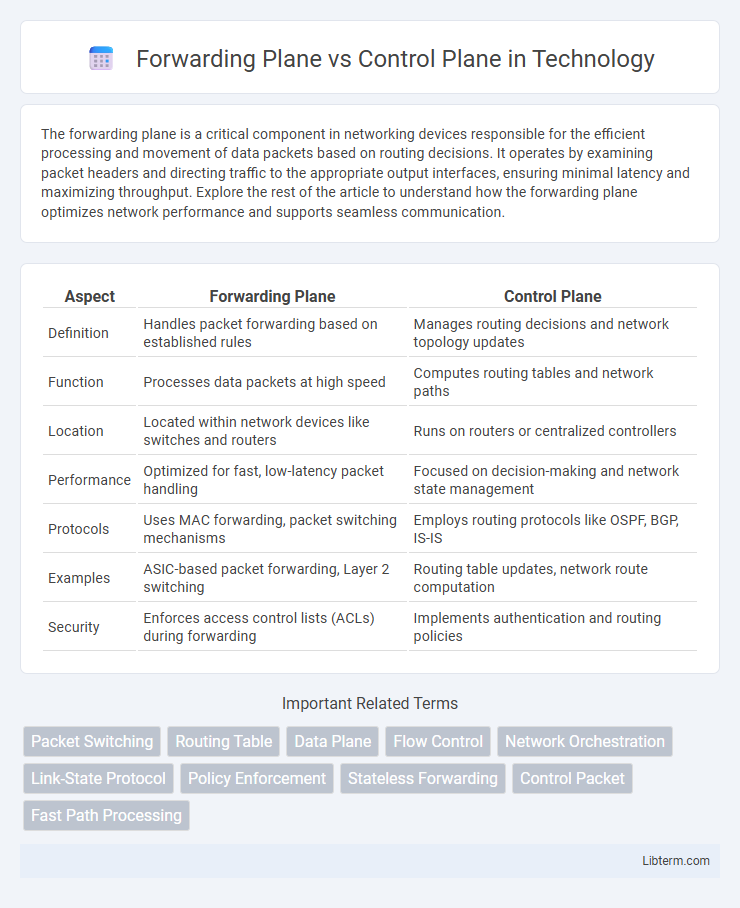The forwarding plane is a critical component in networking devices responsible for the efficient processing and movement of data packets based on routing decisions. It operates by examining packet headers and directing traffic to the appropriate output interfaces, ensuring minimal latency and maximizing throughput. Explore the rest of the article to understand how the forwarding plane optimizes network performance and supports seamless communication.
Table of Comparison
| Aspect | Forwarding Plane | Control Plane |
|---|---|---|
| Definition | Handles packet forwarding based on established rules | Manages routing decisions and network topology updates |
| Function | Processes data packets at high speed | Computes routing tables and network paths |
| Location | Located within network devices like switches and routers | Runs on routers or centralized controllers |
| Performance | Optimized for fast, low-latency packet handling | Focused on decision-making and network state management |
| Protocols | Uses MAC forwarding, packet switching mechanisms | Employs routing protocols like OSPF, BGP, IS-IS |
| Examples | ASIC-based packet forwarding, Layer 2 switching | Routing table updates, network route computation |
| Security | Enforces access control lists (ACLs) during forwarding | Implements authentication and routing policies |
Introduction to Forwarding Plane and Control Plane
The Forwarding Plane processes and directs packets based on pre-defined rules, handling the actual movement of data through the network hardware. The Control Plane manages network routing decisions, building and updating the routing tables by exchanging protocol information between devices. Together, these planes ensure efficient data delivery and network stability by separating packet forwarding from routing logic.
Definitions: What is the Forwarding Plane?
The Forwarding Plane, also known as the data plane, is responsible for the actual movement of packets through a network device by processing and forwarding data based on pre-established routing information. It operates at high speed, matching incoming packets against forwarding tables to determine the correct output interface for transmission. Unlike the Control Plane, which manages routing decisions and network topology, the Forwarding Plane ensures efficient packet delivery without making dynamic routing changes.
Definitions: What is the Control Plane?
The Control Plane is the network layer responsible for making decisions about where traffic is sent, managing routing protocols, and maintaining the routing tables that direct packet forwarding. It processes signaling and control information to establish paths and network topology awareness. Unlike the Forwarding Plane, which handles actual packet transmission, the Control Plane orchestrates network intelligence and policy implementation.
Key Functions of the Forwarding Plane
The forwarding plane is responsible for the high-speed processing and transfer of data packets based on pre-established routing tables and policies, enabling efficient movement of traffic through network devices. It handles tasks such as packet forwarding, filtering, and encapsulation while leveraging ASICs or specialized hardware for rapid decision-making. This separation allows the control plane to focus on route computation and network topology management without being burdened by data packet processing.
Core Roles of the Control Plane
The Control Plane is responsible for making decisions about where traffic is sent by managing routing tables and signaling protocols, enabling efficient network path determination and policy enforcement. It maintains network topology awareness through protocols like OSPF, BGP, and IS-IS, ensuring dynamic route calculation and adaptive network management. Core roles include processing routing information, distributing control messages, and updating forwarding tables in the Forwarding Plane for packet delivery.
Forwarding Plane vs Control Plane: Major Differences
The Forwarding Plane handles packet processing and data transfer based on pre-established routing information, ensuring efficient traffic flow through network devices. The Control Plane is responsible for network topology discovery, routing decisions, and maintaining the routing table by running protocols like OSPF, BGP, or RIP. Forwarding Plane operates at high-speed hardware level for real-time data forwarding, whereas Control Plane functions at the software level, managing network logic and policy enforcement.
Interactions Between Forwarding and Control Planes
The forwarding plane executes packet forwarding decisions based on routing tables provided by the control plane, which is responsible for network topology management and path computation. Interaction between the forwarding and control planes ensures efficient data packet delivery and dynamic network updates by exchanging routing information and forwarding rules. This collaboration allows rapid adaptation to network changes while maintaining optimal traffic flow and overall network stability.
Importance in Network Architecture
The Forwarding Plane handles data packet transmission, ensuring efficient and fast movement through network devices, which is crucial for maintaining high performance and low latency. The Control Plane manages routing decisions and network topology updates, providing the intelligence required to optimize paths and maintain network stability. Together, these planes form the backbone of network architecture, balancing speed and control to support scalable and reliable communications.
Forwarding and Control Plane in Modern Networking (SDN & NFV)
The Forwarding Plane in modern networking, including Software-Defined Networking (SDN) and Network Functions Virtualization (NFV), is responsible for the high-speed packet forwarding based on predefined rules, enabling efficient data flow across the network. The Control Plane, separated from the forwarding hardware in SDN architectures, centralizes network intelligence by managing routing decisions, policy enforcement, and network topology updates through programmable controllers. NFV complements this by virtualizing network functions, enhancing the flexibility and scalability of both forwarding and control processes within dynamic software-driven environments.
Conclusion: Choosing the Right Approach for Your Network
Selecting the appropriate approach between Forwarding Plane and Control Plane depends on network complexity and performance requirements. Forwarding Plane excels in high-speed data packet processing using hardware-based switching, while Control Plane is essential for dynamic routing and decision-making through software-based protocols. Balancing these planes ensures optimized network efficiency, scalability, and reliability tailored to specific organizational needs.
Forwarding Plane Infographic

 libterm.com
libterm.com